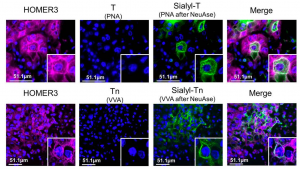A group from Portuguese Institute of Oncology, etc. has reported that HOMER3 with sialyl-T and sialyl-Tn antigen could be a therapeutic target for bladder cancer (BC).
https://www.ncbi.nlm.nih.gov/pmc/articles/PMC8188679/
A total of 10 major glycans structures were identified for both BC cell lines: 5637 and T24, which present similar O-glycomes. Notably, both cell lines expressed high levels of mono- and di-sialylated T antigens (sialyl-T), also exhibiting neutral core 1 and sialylated and/or fucosylated core 2 structures
Based on glycomics analysis, samples were first enriched for membrane proteins by differential ultracentrifugation of whole cell protein extracts, digested with sialidase and enriched for T antigen expressing glycoproteins by PNA affinity pulldowns. The glycoproteins were identified by conventional bottom-up proteomics after trypsin digestion and analysis by nanoLC-CID-MS/MS. As a result, over 900 glycoproteins were identified as potentially expressing sialyl-T.
Among these, GLUT1(SLC2A1) and HOMER3 ranked first, suggesting potential for targeted therapeutics. GLUT1 is a pivotal membrane glucose transporter frequently overexpressed in more aggressive bladder tumours. HOMER3 has been implicated in neuronal signaling, T-cell activation and trafficking of beta amyloid peptides. HOMER3 at the cell membrane co-localizes in the same tumour area with sialyl-Tn and sialyl-T antigens in BC. According to immunohistochemistry, HOMER3 was diffusely expressed in wide tumour areas, both at the cytoplasm and cell membranes. These areas co-localized with very high sialyl-Tn and/or sialyl-T expressions areas.

